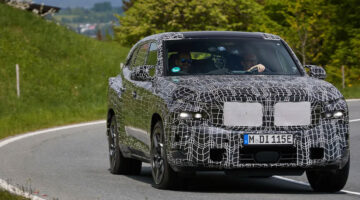It’s been a long road of concepts cars, teaser images, development drives and the deployment of a WEC racing car, but the road-going production version of the BMW 8-series Coupe finally will finally be revealed in full at this year’s Le Mans 24h.
We already know much about the new 8-series, including how it should drive when it reaches customers later in the year, thanks to our drive in a pre-production prototype M850i. Le Mans, however, will be the first time the public will get to see the car undisguised as BMW prepares to put it in showrooms later in 2018.
Unless you’ve been hiding underneath a rock for the last 12 months, you’ll already know is that the new BMW 8-series will act as BMW’s sporting flagship coupe, replacing the 6-series coupe and convertible with a larger, more elaborate GT car due to compete with the Mercedes S-class Coupe and Aston Martin DB11. This is the second time BMW has used the 8-series badge that first appeared in the early 1990s on the back of a svelte four-seater coupe.

This time, alongside the two-door coupe, BMW will also build convertible and four-door Gran Coupe versions of the 8-series, all with four seats and a range of six and eight cylinder engine options.
BMW M will also finally get its opportunity to produce an M8, with the performance GT borrowing a 4.4-litre twin-turbocharged V8 engine from the BMW M5. Although the M8 nomenclature has never been used in the past, the new car does have a spiritual successor in the form of the BMW 850CSi, a limited-run performance version of the previous 8-series coupe, which featured a 5-litre V12 that was a precursor engine to the one used in the McLaren F1, no less.
Up to this point, BMW has granted us access to a camouflaged pre-production test vehicle, as well as revealing two concept cars, one a standard 8-series coupe and the other an M8 Gran Coupe at this year’s Geneva motor show. In combination this has given us a good idea of what to expect from the production car style-wise. Below is our interview with the new 8-series’ designer John Buckingham, at an exclusive studio shoot of the first 8-series concept car.
BMW 8-series concept revealed
A photographic studio could possibly be the worst place to get an impression of a new car. Unnatural light pointing in all manner of angles often exaggerates a vehicle’s features and can make them look obscure. Then also, with nothing really familiar give an accurate idea of the scale they often look huge.
Still, even though I’m prepared for the BMW 8-series concept to look vast, when I arrive at the rented studio to interview the car’s designer, John Buckingham, I can’t help but be surprised at just how big it seems. Pleasingly, though, it’s still pretty under the studio lights. In fact, much better looking than it is in pictures.
Not long after I arrive the photographers get busy setting up, and for a moment the entire lower half of the car is obscured. With just a view of the bonnet and roofline, you wouldn’t recognise the new 8-series as a BMW at all.
‘BMWs are typically made up of a three-box shape profile; this is more of a two-box with a single line stretching from the roof right to the back of the boot,’ explains Buckingham. Despite this, as soon as the whole car is visible again, it couldn’t be anything but one of Munich’s finest.
That’s partly thanks to the car’s finer features. ‘Some of the BMW details have been exaggerated, like the kidney grille. The simple profile gives you more freedom to be abstract with the details.’
But that isn’t the whole story; much of the BMW look comes from an approach to design rather than specific aesthetic styles, and it’s not something that’s easy to define. ‘It’s about feel. You can make something look new, but feel BMW. Or the way you treat surfaces so they feel very BMW.’
This 8-series concept really does have to look like a BMW, because not only does it preview a new product, which will be the 8-series, it’s our first look at a new design language that will dictate what the next generation of BMWs will look like.

As the 8-series will be the flagship of the range, other BMWs won’t look quite so luxurious. This concept is finished with high-value features and materials that are typical of a luxury car, including carbonfibre as well as polished and brushed aluminium. But its high-end manner doesn’t just come from its details, ‘the surfaces and silhouette had to reflect that, too.’
The philosophy behind the new 8-series was about creating a gentleman’s racer, a luxury GT car and that means there has to be an obvious performance attitude to the way it looks as well as feeling very premium. Much of its sportiness comes from its prominent rear hips; the body swells out around the rear wheels making it look very rear-wheel drive.
How the swollen rear hips integrate with the rest of the car is one of things that Buckingham is most proud of. As he shows me the section above the rear wheels it’s clear that he’s worked very hard on this area. The result is that the enlarged arches intersect with the rounded shoulder line as well the creases down the flanks without creating any awkward sections or angles. That sounds easy when you say it, but Buckingham assures me it took a lot of perfecting.
Different elements combining together give Buckingham the opportunity to design in the way he enjoys the most. ‘I like playing with reflection and surfaces […] Using full and integrated surfaces with precise creases.’ This attitude is clearly visible in the flowing, sculpted sides – that direct air right from the front of the vehicle to around the rear wheel – and the fine, subtle creases on the lower sill and one that stretches from the bonnet, up the a-pillar and then along the roof. Each element creates a succession of highlights and shadows that run horizontal across the car.

With such an obsession about light and shadow, the paint and colour was critical to Buckingham. Particularly important was the metallic property of the finish, ‘it gives it depth, which accentuates and supports the shape.’ He describes the colour as ‘serious’, it’s very grown-up and sophisticated and suits the image of a luxury GT car. Its cool finish perfectly accompanies the brushed aluminium brightwork, too.
The 8-series isn’t all about balanced, complementary elements though; the softer, flowing, more elegant lines of the body that manage the air flowing over the car are contrasted by the aspects relating to the engine and performance. The elements linked to the car’s mechanics – like the dark geometric mesh vents, carbonfibre ducts and trapezoidal exhausts – are all found on the lower half of the car and have been kept purposefully industrial looking.
Another aspect that Buckingham is very proud of are the car’s wheels. He admits he’s not really a wheel designer, but looking at the 8-series concepts wheels you’d never guess. They’re typically concept car huge in diameter but much of the drama comes from their deep centres that give them real shape. Get closer and you notice extra black elements woven through the spokes that Buckingham explains is to emphasize the impression of air passing through the wheels.

There’s a close relationship between the new 8-series’ interior and exterior. Peering through the rear screen you see the shape of the glass is matched by the rear stitching and speaker surrounds on the parcel shelf. The luxury GT theme is even stronger on the inside thanks to brown suede, quilted leather and a special carbonfibre with an aluminium thread woven into it.
Best of all, though, is the suede rimmed deeply dished steering wheel with brushed aluminium spokes and red gearshift paddles. It’s reminiscent of the extremely dished wheels found in wedgey concept cars in the late sixties and early seventies, but modern enough to look perfectly at home in the 8-series.
This article originally appeared at evo.co.uk
Copyright © evo UK, Dennis Publishing



